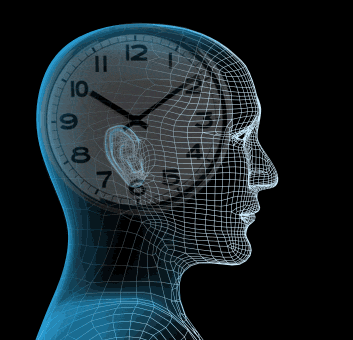TUESDAY, 3 JUNE 2014
Biological rhythms are mechanisms generated inside organisms that synchronize cellular and physiological processes with periodic cycles in the environment. This synchrony ensures that daily peaks in energy metabolism, gastrointestinal tract motility, cardiovascular activity, endocrine secretion, body temperature, and cognitive processes occur at optimal times of the day. Coordinating internal processes with the external environment optimizes energy expenditure and may provide an evolutionary advantage by ensuring activities are performed at ideal times for finding food and mating partners, and avoiding predators.
In humans, the suprachiasmatic nucleus (SCN) in the hypothalamus region of the brain is the central clock and master pacemaker. The SCN is synchronized by daily light-dark cycles and coordinates the timing of other physiological rhythms. Anyone who has experienced jet-lag or shiftwork understands the strong influence SCN timekeeping has on sleep-wake behaviours. Sleep disturbances, fatigue, and cognitive deficits are common when the body’s rhythms are not synchronized with external cycles. In humans and animals in general, the loss of normal biological rhythms can increase morbidity and mortality.
Recently, researchers at the University of Cambridge developed a transgenic fruit fly expressing a protein called amyloid beta peptide (Aβ), which is one of the hallmark abnormalities of patients with AD. The goal was to develop an animal model to study sleep-wake disturbances associated with AD. The group, led by Dr. Damian Crowther, showed that Aβ expression in the fruit fly model resulted in age-related disturbances in circadian rhythms, causing sporadic sleep-wake behaviours. Surprisingly, despite the behavioural irregularities, the central timekeeping mechanism appeared intact.
This was the first experimental animal model to show progressive circadian deficits analogous to those experienced by AD patients and to demonstrate that the sporadic sleep-wake behaviours were not due to an arrhythmic internal timekeeping mechanism. These findings suggest that the cause of the behavioural arrhythmia is generated by a disruption in the communication between the central (SCN) timekeeping mechanism and the peripheral rhythms controlling sleep-wake behaviour. In future research scientists should look at whether the SCN of AD patients stays entrained to daylight while the peripheral rhythms affecting behaviour become out of sync. If circadian behavioural abnormalities in patients are not caused by a loss of SCN function but by damage in downstream pathways, then it could have potential implications for treatment and prevention of AD.
Currently, light therapy is sometimes used in an attempt to enhance circadian rhythmicity, and improve quality of sleep for AD patients. Light therapy can help re-establish synchrony among rhythms throughout the body and can help sustain daytime waking to stimulate activity, raise body temperature, and increase appetite. Nevertheless, other processes, like timing of food intake, can also affect the synchrony of rhythms.
If in AD patients the SCN is indeed intact but no longer in sync with other rhythms, it may be possible to use scheduled mealtimes, or one of the body’s natural triggers of hunger, to bring physiological processes back in sync. For example, ghrelin, a stomach hormone that controls appetite, may help synchronize rhythms. Over the past 10 years there has been accumulating evidence that in addition to regulating hunger, ghrelin has direct effects on learning and memory processes, as well as having beneficial effects on AD symptoms in mice. It may be possible that appropriately timed administration of ghrelin could be a method for synchronizing internal rhythms, while also providing cognitive benefits for AD patients.
Studying circadian rhythm disruption in AD holds great promise for accessible treatments. Harmonious interaction of internal and environmental rhythms ensures the optimal timing of physiological processes, which is best for longevity. If scientists and doctors look for early cues of internal rhythms becoming uncoupled, we may be able to use a combination of light therapy, scheduled mealtimes, and other interventions to slow down the progression of Alzheimer’s disease.

